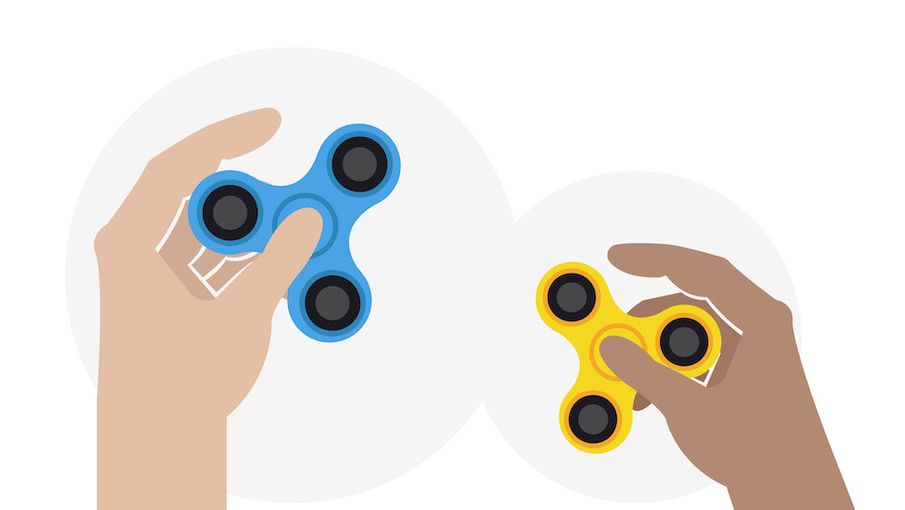Do you ever find yourself tapping, or clicking your pen, without realising it? Perhaps you twirl your hair when you’re feeling nervous? If so, you could be stimming
Everyone remembers fidget spinners. For a brief period between 2017 and 2018, it seemed like everyone had one. While most of us saw them as a bit of fun (or a potential playground hazard at worst), many people didn’t realise the impact fidget spinners could have for those with anxiety, ADHD, or who are on the autistic spectrum.
While the clamour for fidget spinners may have been and gone, for many of us, other items have taken their place. Whether you’ve ever had a stress ball, or have given in to the current trend for squishies, chances are, you’ve tried at least one stimming-related toy.
I rarely go anywhere without my own fidget cube – a small cube with buttons, switches, dials, and a joystick. In meetings, it helps me to focus and release nervous tension; in crowded places, it gives me something to focus on to feel less anxious. But is stimming – short for ‘self-stimulatory behaviour’ – really healthy, and why do we do it?
What is stimming?
Stimming refers to a repetitive action or movement, typically displayed by those on the autistic spectrum. Common stims can include spinning or fidgeting with objects, pacing, repeating noises or words, or hand-flapping.

While some people who are on the spectrum may more overtly stim, we all stim in one way or another. We may call or think of it as something else, such as a nervous tick, or refer to it as a ‘bad habit’ we fall back on when experiencing certain emotions like anxiety, or stressful situations. It’s only when that stimming may get out of control that we might notice it.
Cognitive research suggests that how much we fidget is linked with how stimulated we feel. It can help both to calm us, and energise us, as needed.
Why do we do it?
The different reasons why we stim can be as varied as the types of stimming we do. You might stim to relieve some tension because you’re nervous, when you’re bored, or when you’re having trouble concentrating. It can become a harmless habit that you may not even be aware that you’re doing.
Stimming can also be a way to reduce feelings of anxiety, and to feel calmer. If you are trying to deal with an unexpected change or situation, are stressed, feel frustrated or overwhelmed, stimming can act as an outlet for the tension or unsettled feelings you may be unable to otherwise express.
Is stimming bad?
Typically? No. Stimming doesn’t have to be something that needs to be stopped or stifled. It’s only if it starts to interfere with your day-to-day life, or if it is seriously impacting those around you, that it could be worth seeing if there is anything you can do about it.
If you struggle with anxiety, are on the spectrum, or experience sensory overload, stimming can help you to feel calmer
If you have developed a stim that is causing you to hurt yourself, or is unintentionally harming you (or others), such as repeated rubbing or scratching at your skin, or biting your nails until they bleed, it could be worth seeking help. With support, you can reduce or stop harmful stimming, or refocus your actions to more harmless, self-soothing stims.
Should I try to stop?
Unless stimming has caused you a social or physical problem, there shouldn’t be a need to try to stop. If in doubt, ask yourself:
- Is stimming disruptive at work?
- Does stimming cause problems for me, or those around me?
- Are my stims dangerous or destructive?
If you’re worried about your stimming, there are some simple things you can try to help manage it. However, it’s important to try to figure out why you are stimming: is it because you are feeling nervous, anxious, or perhaps bored? In many ways, stimming is a form of communication. Trying to figure out what you are feeling or doing to cause this unexpected way of communicating, can help you to feel more in control.
Can stimming be a good thing?
If you struggle with anxiety, are on the spectrum, or experience sensory overload, stimming can help you to feel calmer, as it offers an outlet as well as a focal point. Next time you find yourself clicking, tapping, or twirling, it could be worth taking a moment to step back and ask yourself: how am I feeling right now?
For more information on managing anxiety visit counselling-directory.org.uk


Comments